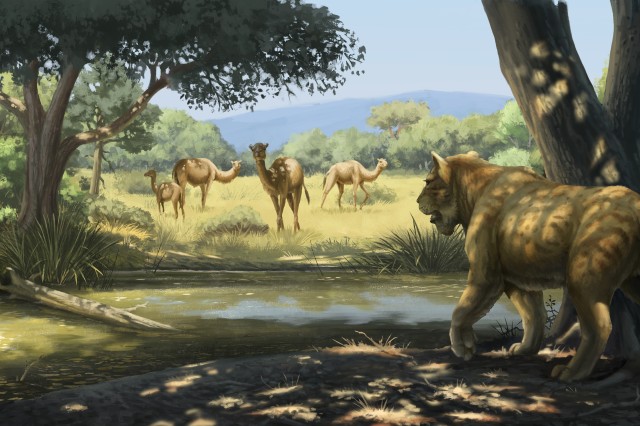The museum will be closed Thursday, January 1 for New Year's Day. We will reopen Friday, January 2.

Published November 8, 2023
Take a walk through Hancock Park early enough in the morning, and you might just run into one of the largest surviving Ice Age predators: the coyote, Canis latrans.
Ice Age Evidence
Iconic megafauna like giant ground sloths and saber-toothed cats come to mind when we think of Los Angeles in the last Ice Age, but coyotes are the third-most abundant large mammal found at La Brea Tar Pits alongside massive meat-eaters like saber-toothed cats and dire wolves—and there aren’t frequent dire wolf sightings in the suburbs. Coyotes are one of the most visible throughlines between modern L.A. and the region’s Pleistocene past.

La Brea Tar Pits researchers recently produced groundbreaking research laying out the causes of the megafaunal extinction event that claimed iconic Ice Age mammals like the saber-toothed cat and western camel around 13,000 years ago. Compiling vast evidence, they found the extinction event was predominantly caused by human-ignited fires in an ecosystem destabilized by rising temperatures, a changing habitat, and a megadrought lasting centuries. Tar Pits fossils help explain how coyotes outlasted their larger competitors.

Coyotes of the last Ice Age were bigger and stronger than their modern descendants, possibly to better compete with the likes of dire wolves and saber-toothed cats when hunting plant-eating megafauna like western camels and bison. Those larger bodies would be harder to keep fed once the bigger prey died out. Researchers looking at how coyote size changed found that within 1,000 years of the megafauna extinction, coyotes had reached their modern, smaller size. Tar Pits researchers looked at the microscopic wear of their teeth to find out the details of coyotes’ evolving diets.

Analyzing the tooth enamel of Tar Pits predators and looking at the isotopes within to reveal what these fossilized hunters were feeding on, Tar Pits Research Associate Dr. Larisa De Santis found that the big cats preferred prey living in the forests while dire wolves preferred meals on the run like bison and horses grazing in grasslands. The changing climate and human-caused fires led the biggest herbivores to extinction, and without their prey, the Ice Age predators followed suit. Along with other predators like cougars and gray wolves, De Santis found that coyotes survived by adapting their diets to smaller mammals and scavenging carcasses. The ability to change diets is just one way coyotes continue to thrive on a continent reshaped by humans.
Modern Survival Skills
Coyotes have a suite of survival skills remarkably similar to our own. While their larger cousin the wolf hunts exclusively in packs, coyotes are pack-hunters that can also live and find prey on their own, a tactic biologists refer to as fission-fusion. When resources become scarce or coyotes find themselves hunted, packs split up and lone animals hunt smaller prey for themselves. Solo coyotes eat everything from rodents to insects to fruit.
Another key to their success? Coyotes engage in a sort of family planning. Coyote litter sizes can vary dramatically from a single pup to as many as 19 in a litter. When more coyotes are killed by larger predators or hunters, females respond by increasing the size of their litter. When there are as many coyotes as a habitat can handle, females decrease their litter sizes.

“Canis latrans” literally means “barking dog” (one of their other many common names is “song dog”), and their vocalizations are another tool that helps coyotes survive. Coyotes use growls, whines, and barks in the same way as other canids. Their iconic yipping howl works as a sort of audible census, letting individuals know if it’s time to stock up on cubs. Communication lets coyotes respond to changes that might otherwise overwhelm them.
These adaptations helped coyotes overcome efforts by the United States government to eradicate them beginning in the early 1900s. Their intelligence and adaptability helped them survive hunters, traps, and cyanide poisoning to the point where these "prairie wolves" are now found in every state (except Hawaii). If coyotes seem exceptionally at home in cities, it may be because they’ve had a lot of practice.

Sometimes a source of creativity or malevolence, Coyote plays a large role in the oral histories of many Native peoples of the North American West and Southwest as a trickster whose mischief sometimes leads to profound changes for the Earth. “Historically, Coyote often does things that people shouldn’t do and teaches us that there are usually repercussions,” says Indigenous artist L. Frank Manriquez.
So if you happen to see a coyote in your neighborhood—definitely keep a safe distance, and take a photo for iNaturalist—but remember you’re looking at an Ice Age survivor. As we face rising temperatures, changing habitats, and wildfires in an ominous parallel to the Ice Age megafauna extinction event on a planetary scale, there is still much to learn from coyotes about adaptation and from Coyote about repercussions.

